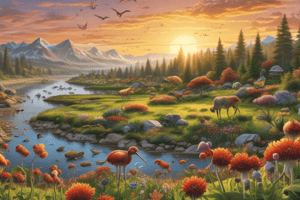Podcast
Questions and Answers
Why don't populations of organisms grow indefinitely?
Why don't populations of organisms grow indefinitely?
Limiting factors affect survival rates. Exceeding carrying capacity reduces populations.
The number of organisms of one species that an environment can support is called its _____.
The number of organisms of one species that an environment can support is called its _____.
Carrying capacity
If the number of organisms in a population is _____ the environment's carrying capacity, births _____ deaths and the population _____.
If the number of organisms in a population is _____ the environment's carrying capacity, births _____ deaths and the population _____.
Under; exceed; grows
If the number of organisms rises _____ the carrying capacity of the environment, _____ will exceed _____.
If the number of organisms rises _____ the carrying capacity of the environment, _____ will exceed _____.
This pattern will continue until the population is once again at or _____ the carrying capacity.
This pattern will continue until the population is once again at or _____ the carrying capacity.
The most important factor that determines population growth is the organism's _____.
The most important factor that determines population growth is the organism's _____.
What do organisms that follow a rapid life-history pattern do?
What do organisms that follow a rapid life-history pattern do?
What do organisms that follow a slow life-history pattern do?
What do organisms that follow a slow life-history pattern do?
A limiting factor that has an increasing effect as population size increases is _____.
A limiting factor that has an increasing effect as population size increases is _____.
Explain how the lynx population size changes when the hare population increases.
Explain how the lynx population size changes when the hare population increases.
Explain how the change in the lynx population size affects the hare population.
Explain how the change in the lynx population size affects the hare population.
What is the relationship between the lynx and the hare called?
What is the relationship between the lynx and the hare called?
When does competition decrease the size of a population?
When does competition decrease the size of a population?
What can cause an organism to exhibit stress, and what symptoms of stress can lead to a decrease in population size?
What can cause an organism to exhibit stress, and what symptoms of stress can lead to a decrease in population size?
What is a population?
What is a population?
What is a simple way for a biologist to study population growth?
What is a simple way for a biologist to study population growth?
How is population growth different than growth of job income?
How is population growth different than growth of job income?
What is exponential growth?
What is exponential growth?
Can biological populations grow exponentially?
Can biological populations grow exponentially?
What does a graph of an exponentially growing population look like?
What does a graph of an exponentially growing population look like?
What is carrying capacity?
What is carrying capacity?
Name 4 abiotic factors that affect carrying capacity.
Name 4 abiotic factors that affect carrying capacity.
Name 4 biotic factors that affect carrying capacity.
Name 4 biotic factors that affect carrying capacity.
How does birth rate compare to death rate when a population is under carrying capacity? Over carrying capacity?
How does birth rate compare to death rate when a population is under carrying capacity? Over carrying capacity?
Describe organisms that have a rapid life history. Give 2 examples.
Describe organisms that have a rapid life history. Give 2 examples.
Describe organisms that have a long life history. Give 2 examples.
Describe organisms that have a long life history. Give 2 examples.
What is a density-dependent factor? Give 3 examples.
What is a density-dependent factor? Give 3 examples.
What is a density-independent factor? Give 3 examples.
What is a density-independent factor? Give 3 examples.
How does predation affect population? Give an example.
How does predation affect population? Give an example.
How does competition affect population? Give an example.
How does competition affect population? Give an example.
How does crowding and stress affect population? Give an example.
How does crowding and stress affect population? Give an example.
Flashcards
Carrying Capacity
Carrying Capacity
The maximum number of organisms an environment can support due to limiting factors.
Population Growth (under carrying capacity)
Population Growth (under carrying capacity)
When birth rates exceed death rates, leading to population growth.
Population Decline (over carrying capacity)
Population Decline (over carrying capacity)
When death rates exceed birth rates, causing the population to decline.
Rapid Life-History Organisms (R-strategists)
Rapid Life-History Organisms (R-strategists)
Signup and view all the flashcards
Slow Life-History Organisms (K-strategists)
Slow Life-History Organisms (K-strategists)
Signup and view all the flashcards
Competition
Competition
Signup and view all the flashcards
Predator-Prey Relationship
Predator-Prey Relationship
Signup and view all the flashcards
Population
Population
Signup and view all the flashcards
Exponential Growth
Exponential Growth
Signup and view all the flashcards
Abiotic Factors (Affecting Carrying Capacity)
Abiotic Factors (Affecting Carrying Capacity)
Signup and view all the flashcards
Biotic Factors (Affecting Carrying Capacity)
Biotic Factors (Affecting Carrying Capacity)
Signup and view all the flashcards
Density-Dependent Factors
Density-Dependent Factors
Signup and view all the flashcards
Density-Independent Factors
Density-Independent Factors
Signup and view all the flashcards
Crowding and Stress (Population)
Crowding and Stress (Population)
Signup and view all the flashcards
Study Notes
Population Growth Fundamentals
- Populations cannot grow indefinitely due to limiting factors which impact survival rates.
- Carrying capacity defines the maximum number of organisms an environment can support.
Population Dynamics
- When a population is under carrying capacity, birth rates exceed death rates, leading to population growth.
- Conversely, if a population exceeds carrying capacity, death rates surpass birth rates, causing decline.
- The population will stabilize at or below carrying capacity.
Reproductive Patterns
- Organisms' reproductive patterns significantly influence population growth.
- Rapid life-history organisms have short lifespans, small body sizes, and reproduce early.
- Slow life-history organisms tend to reproduce slowly and often have longer lifespans.
Limiting Factors
- Competition is a density-dependent limiting factor that intensifies as population size increases.
Predator-Prey Relationships
- Snowshoe hares serve as a primary food source for Canadian lynx; an increase in hare population leads to an increase in lynx population, while a rise in lynx results in a decrease in hare population.
- This interaction exemplifies a predator-prey relationship.
Competition and Stress
- Competition decreases population size when resource demand exceeds supply.
- Overcrowding can induce stress in populations, leading to aggression, reduced parental care, lower fertility, and increased disease susceptibility.
Defining Populations
- A population consists of a group of organisms of the same species that interbreed and share the same habitat.
Studying Population Growth
- An effective method for analyzing population growth involves using bacterial cultures in petri dishes.
Growth Patterns
- Biological populations can exhibit exponential growth, characterized by rapid increases that double during fixed time intervals.
- A typical graph of exponential growth shows a J-shaped curve, reflecting slow, steady, and then rapid growth phases.
Factors Affecting Carrying Capacity
- Factors that influence carrying capacity include:
- Abiotic: Water, sunlight, nutrients, oxygen.
- Biotic: Food availability, predation, competition, parasites.
Birth and Death Rates
- When a population is under carrying capacity, the birth rate surpasses the death rate. When over, the situation reverses.
Life History Strategies
- Rapid life-history organisms (R-strategists): thrive in unpredictable environments, e.g., bacteria and rabbits.
- Long life-history organisms (K-strategists): thrive in stable environments, e.g., humans, elephants, and whales.
Density-Dependent and Density-Independent Factors
- Density-dependent factors (e.g., disease, competition) become more impactful as population size increases.
- Density-independent factors (e.g., temperature, storms, floods) impact all populations regardless of density, often abiotic in nature.
Effects of Predation
- Predation can significantly affect prey populations. For instance, locusts devastate crops by consuming all available lettuce.
Impact of Competition
- Increased population results in higher competition for limited resources, potentially leading to decreased population sizes.
Crowding and Stress
- Crowding can result in stress-related behaviors among individuals, contributing to various negative effects on population health and viability.
Studying That Suits You
Use AI to generate personalized quizzes and flashcards to suit your learning preferences.




